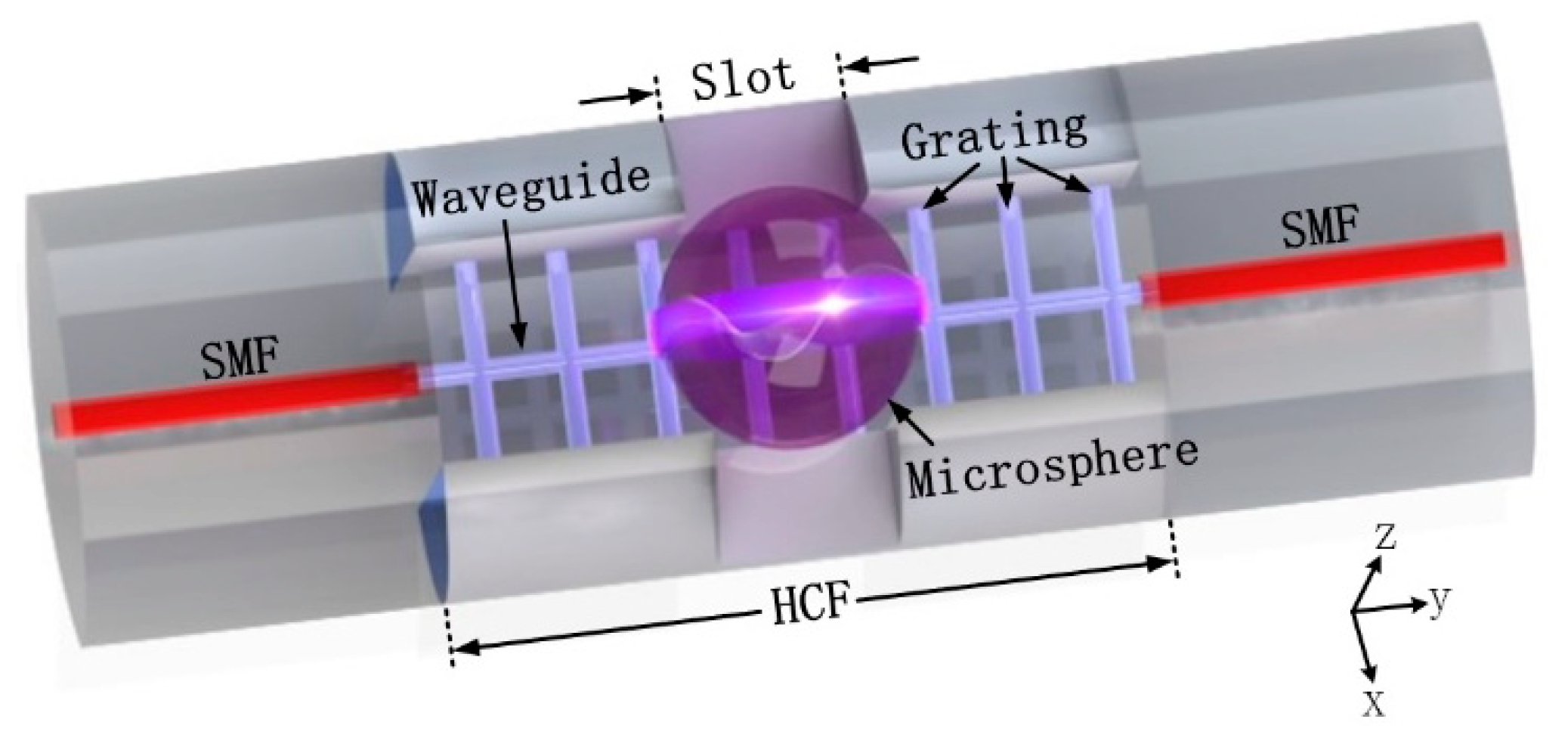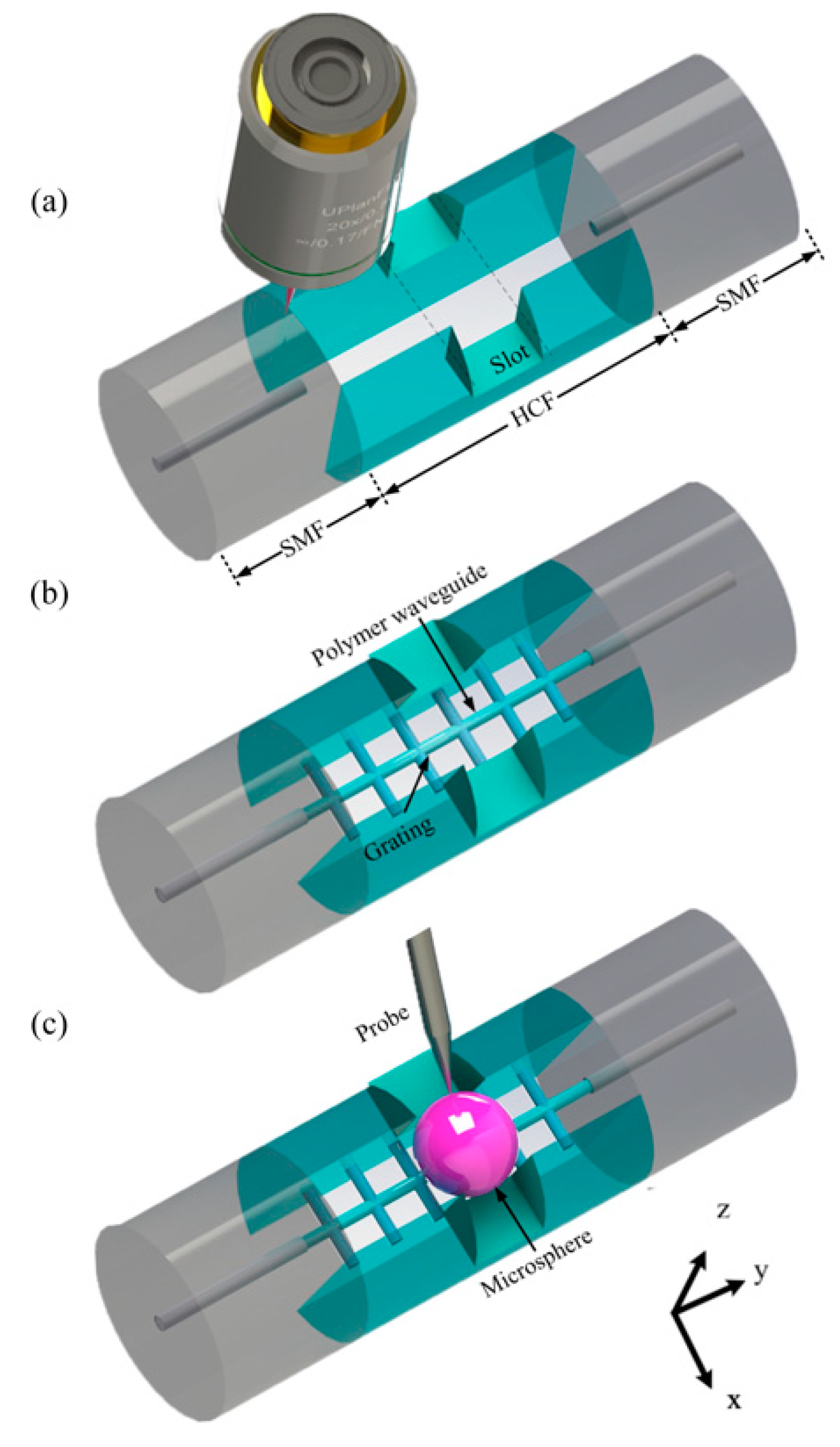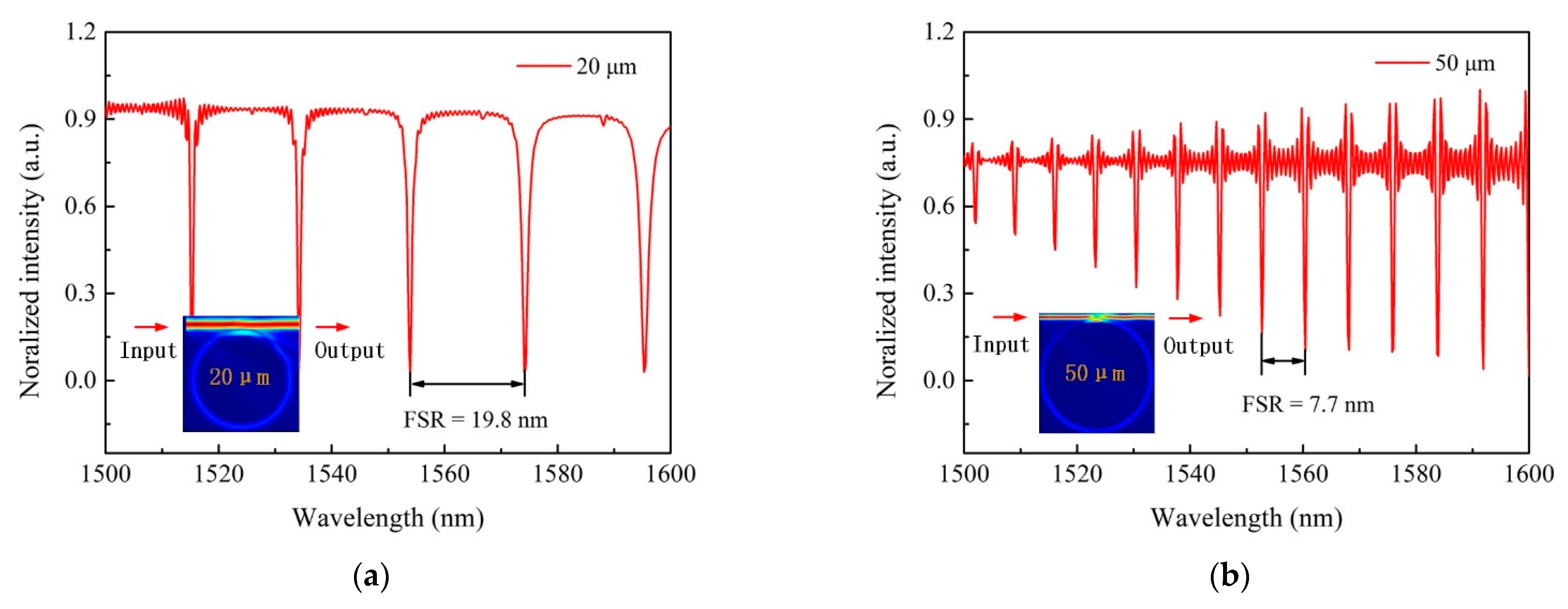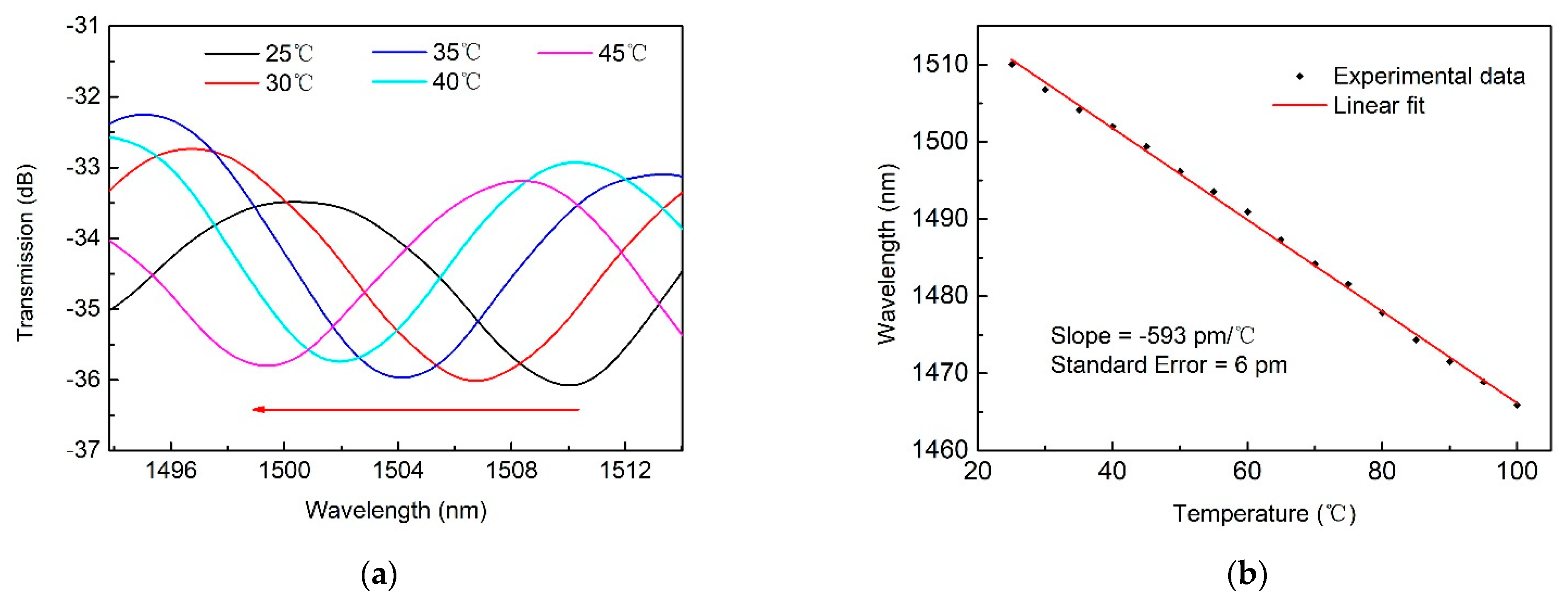In-Fiber BaTiO3 Microsphere Resonator for High-Sensitivity Temperature Measurement
Abstract
:1. Introduction
2. Materials and Methods
3. Results and Discussion
4. Conclusions
Author Contributions
Funding
Institutional Review Board Statement
Informed Consent Statement
Data Availability Statement
Conflicts of Interest
References
- Trocha, P.; Karpov, M.; Ganin, D.; Pfeiffer, M.H.P.; Kordts, A.; Wolf, S.; Krockenberger, J.; Marin-Palomo, P.; Weimann, C.; Randel, S.; et al. Ultrafast optical ranging using microresonator soliton frequency combs. Science 2018, 359, 887–891. [Google Scholar] [CrossRef] [Green Version]
- Herr, T.; Brasch, V.; Jost, J.D.; Wang, C.Y.; Kondratiev, N.M.; Gorodetsky, M.L.; Kippenberg, T.J. Temporal solitons in optical microresonators. Nat. Photon. 2014, 8, 145–152. [Google Scholar] [CrossRef] [Green Version]
- Kippenberg, T.J.; Gaeta, A.L.; Lipson, M.; Gorodetsky, M.L. Dissipative kerr solitons in optical microresonators. Science 2018, 361, 567. [Google Scholar] [CrossRef] [PubMed] [Green Version]
- Annadhasan, M.; Venkataramudu, U.; Mitetelo, N.V.; Mamonov, E.A.; Sahoo, C.; Naraharisetty, S.R.G.; Murzina, T.V.; Chandrasekar, R. High optical energy storage and two-photon luminescence from solution-processed perovskite-polystyrene composite microresonators. ACS Appl. Energy Mater. 2018, 2, 428–435. [Google Scholar] [CrossRef]
- Aveline, D.C.; Baumgartel, L.M.; Lin, G.; Yu, N. Whispering gallery mode resonators augmented with engraved diffraction gratings. Opt. Lett. 2013, 38, 284–286. [Google Scholar] [CrossRef] [PubMed]
- Bogdanov, A.A.; Mukhin, I.S.; Kryzhanovskaya, N.V.; Maximov, M.V.; Sadrieva, Z.F.; Kulagina, M.M.; Zadiranov, Y.M.; Lipovskii, A.A.; Moiseev, E.I.; Kudashova, Y.V.; et al. Mode selection in inas quantum dot microdisk lasers using focused ion beam technique. Opt. Lett. 2015, 40, 4022–4025. [Google Scholar] [CrossRef] [PubMed] [Green Version]
- Twedt, K.A.; Zou, J.; Davanco, M.; Srinivasan, K.; McClelland, J.J.; Aksyuk, V.A. Imaging nanophotonic modes of microresonators using a focused ion beam. Nat. Photon. 2016, 10, 35–39. [Google Scholar] [CrossRef] [PubMed] [Green Version]
- Moiseev, E.I.; Kryzhanovskaya, N.; Polubavkina, Y.S.; Maximov, M.V.; Kulagina, M.M.; Zadiranov, Y.M.; Lipovskii, A.A.; Mukhin, I.S.; Mozharov, A.M.; Komissarenko, F.E.; et al. Light outcoupling from quantum dot-based microdisk laser via plasmonic nanoantenna. ACS Photon. 2017, 4, 275–281. [Google Scholar] [CrossRef]
- Liu, Z.-P.; Jiang, X.-F.; Li, Y.; Xiao, Y.-F.; Wang, L.; Ren, J.-L.; Zhang, S.-J.; Yang, H.; Gong, Q. High-q asymmetric polymer microcavities directly fabricated by two-photon polymerization. Appl. Phys. Lett. 2013, 102, 221108. [Google Scholar] [CrossRef]
- Huang, Q.L.; Xu, H.L.; Li, M.T.; Hou, Z.S.; Lv, C.; Zhan, X.P.; Li, H.L.; Xia, H.; Wang, H.Y.; Sun, H.B. Stretchable peg-da hydrogel-based whispering-gallery-mode microlaser with humidity responsiveness. J. Light. Technol. 2018, 36, 819–824. [Google Scholar] [CrossRef]
- Hou, Z.S.; Huang, Q.L.; Zhan, X.P.; Li, A.W.; Xu, H.L. Real 3d microsphere lasers by femtosecond laser processing. RSC Adv. 2017, 7, 16531–16534. [Google Scholar] [CrossRef] [Green Version]
- Kelemen, L.; Lepera, E.; Horvath, B.; Ormos, P.; Osellame, R.; Martinez Vazquez, R. Direct writing of optical microresonators in a lab-on-a-chip for label-free biosensing. Lab Chip 2019, 19, 1985–1990. [Google Scholar] [CrossRef] [PubMed] [Green Version]
- Kim, P.; Doss, N.M.; Tillotson, J.P.; Hotchkiss, P.J.; Pan, M.-J.; Marder, S.R.; Li, J.; Calame, J.P.; Perry, J.W. High energy density nanocomposites based on surface-modified batio(3) and a ferroelectric polymer. ACS Nano 2009, 3, 2581–2592. [Google Scholar] [CrossRef] [PubMed]
- Dang, Z.-M.; Yuan, J.-K.; Yao, S.-H.; Liao, R.-J. Flexible nanodielectric materials with high permittivity for power energy storage. Adv. Mater. 2013, 25, 6334–6365. [Google Scholar] [CrossRef] [PubMed]
- Li, C.; Liao, C.; Wang, J.; Li, Z.; Wang, Y.; He, J.; Bai, Z. Femtosecond laser microprinting of a polymer fiber bragg grating for high-sensitivity temperature measurements. Opt. Lett. 2018, 43, 3409–3412. [Google Scholar] [CrossRef] [PubMed]
- Grobnic, D.; Mihailov, S.J.; Ballato, J.; Dragic, P.D. Type i and ii bragg gratings made with infrared femtosecond radiation in high and low alumina content aluminosilicate optical fibers. Optica 2015, 2, 313. [Google Scholar] [CrossRef]
- Pongruengkiat, W.; Pechprasarn, S. Whispering-gallery mode resonators for detecting cancer. Sensors 2017, 17, 2095. [Google Scholar] [CrossRef] [Green Version]
- Liao, C.; Li, C.; Wang, C.; Wang, Y.; He, J.; Liu, S.; Bai, Z.; Gan, Z.; Wang, Y. High-speed all-optical modulator based on a polymer nanofiber bragg grating printed by femtosecond laser. ACS Appl. Mater. 2020, 12, 1465–1473. [Google Scholar] [CrossRef]
- Yee, K.S. Numerical solution of initial boundary value problems involving maxwell’s equation in isotropic media. IEEE Trans. Antennas Propag. 1966, 14, 302–307. [Google Scholar] [CrossRef] [Green Version]
- Ku, J.F.; Chen, Q.D.; Zhang, R.; Sun, H.B. Whispering-gallery-mode microdisk lasers produced by femtosecond laser direct writing. Opt. Lett. 2011, 36, 2871–2873. [Google Scholar] [CrossRef] [Green Version]
- Xiaobei, Z.; Yong, Y.; Huawen, B.; Jiawei, W.; Ming, Y.; Hai, X.; Tingyun, W. Theoretical aspects and sensing demonstrations of cone-shaped inwall capillary-based microsphere resonators. Photon. Res. 2017, 5, 516. [Google Scholar]
- Taylor, T.R.; Hansen, P.J.; Acikel, B.; Pervez, N.; York, R.A.; Streiffer, S.K.; Speck, J.S. Impact of thermal strain on the dielectric constant of sputtered barium strontium titanate thin films. Appl. Phys. Lett. 2002, 80, 1978–1980. [Google Scholar] [CrossRef]
- Jo, W.; Schaab, S.; Sapper, E.; Schmitt, L.A.; Kleebe, H.-J.; Bell, A.J.; Rödel, J. On the phase identity and its thermal evolution of lead free (bi1/2na1/2)tio3-6 mol% batio3. J. Appl. Phys. 2011, 110, 074106. [Google Scholar] [CrossRef] [Green Version]
- Davis, M.; Damjanovic, D.; Setter, N. Electric-field-, temperature-, and stress-induced phase transitions in relaxor ferroelectric single crystals. Phys. Rev. B 2006, 73, 014115. [Google Scholar] [CrossRef]
- Yan, H.; Zhang, H.; Reece, M.J.; Dong, X. Thermal depoling of high curie point aurivillius phase ferroelectric ceramics. Appl. Phys. Lett. 2005, 87, 082911. [Google Scholar] [CrossRef]
- He, Y. Heat capacity, thermal conductivity, and thermal expansion of barium titanate-based ceramics. Thermochim. Acta 2004, 419, 135–141. [Google Scholar] [CrossRef]
- Sawada, S.; Shirane, G. Specific heat and thermal expansion of batio3. J. Phys. Soc. Jpn. 1949, 4, 52–56. [Google Scholar] [CrossRef]
- Liu, X.; Cui, X.L.; Wang, D.N. Integrated in-fiber coupler for a whispering-gallery mode microsphere resonator. Opt. Lett. 2020, 45, 1467–1470. [Google Scholar] [CrossRef] [PubMed]
- Zhang, M.; Yang, W.; Tian, K.; Yu, J.; Li, A.; Wang, S.; Lewis, E.; Farrell, G.; Yuan, L.; Wang, P. In-fiber whispering-gallery mode microsphere resonator-based integrated device. Opt. Lett. 2018, 43, 3961–3964. [Google Scholar] [CrossRef] [PubMed]
- Kosma, K.; Zito, G.; Schuster, K.; Pissadakis, S. Whispering gallery mode microsphere resonator integrated inside a microstructured optical fiber. Opt. Lett. 2013, 38, 1301–1303. [Google Scholar] [CrossRef]





Publisher’s Note: MDPI stays neutral with regard to jurisdictional claims in published maps and institutional affiliations. |
© 2021 by the authors. Licensee MDPI, Basel, Switzerland. This article is an open access article distributed under the terms and conditions of the Creative Commons Attribution (CC BY) license (http://creativecommons.org/licenses/by/4.0/).
Share and Cite
Li, C.; Zhu, M.; Ji, P.; Xiong, C.; Liao, C. In-Fiber BaTiO3 Microsphere Resonator for High-Sensitivity Temperature Measurement. Micromachines 2021, 12, 318. https://doi.org/10.3390/mi12030318
Li C, Zhu M, Ji P, Xiong C, Liao C. In-Fiber BaTiO3 Microsphere Resonator for High-Sensitivity Temperature Measurement. Micromachines. 2021; 12(3):318. https://doi.org/10.3390/mi12030318
Chicago/Turabian StyleLi, Chi, Meng Zhu, Peng Ji, Cong Xiong, and Changrui Liao. 2021. "In-Fiber BaTiO3 Microsphere Resonator for High-Sensitivity Temperature Measurement" Micromachines 12, no. 3: 318. https://doi.org/10.3390/mi12030318
APA StyleLi, C., Zhu, M., Ji, P., Xiong, C., & Liao, C. (2021). In-Fiber BaTiO3 Microsphere Resonator for High-Sensitivity Temperature Measurement. Micromachines, 12(3), 318. https://doi.org/10.3390/mi12030318





